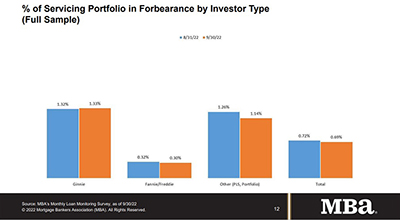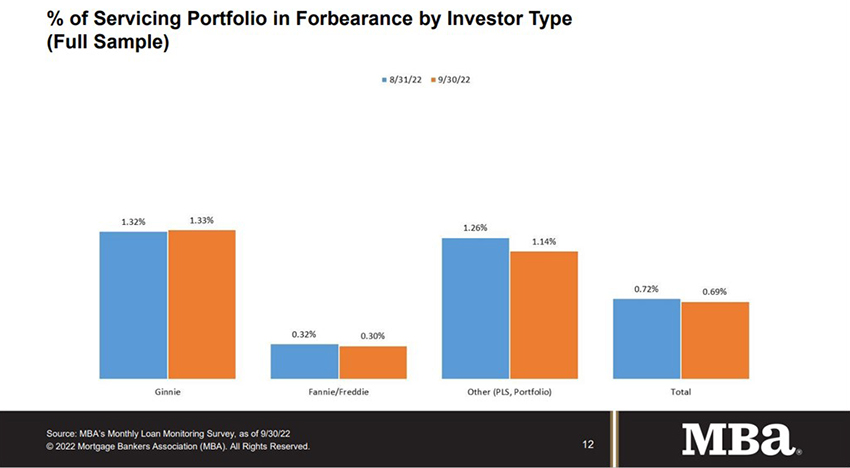
MBA: September Share of Mortgage Loans in Forbearance Decreases to 0.69%

The Mortgage Bankers Association’s monthly Loan Monitoring Survey reported loans in forbearance decreased by 3 basis points to 0.69% of servicers’ portfolio volume as of Sept. 30, down from 0.72% in August. MBA estimates 345,000 homeowners remain in forbearance plans.
The share of Fannie Mae and Freddie Mac loans in forbearance decreased by 2 basis points to 0.30%. Ginnie Mae loans in forbearance increased by 1 basis point to 1.33%, while the forbearance share for portfolio loans and private-label securities declined by 12 basis points to 1.14%.

“The overall number of loans in forbearance dropped in September, but the pace of forbearance exits slowed to a new survey low and new forbearance requests continued to come in,” said Marina Walsh, CMB, MBA Vice President of Industry Analysis. “This dynamic in turn prevented any substantial improvement in the forbearance rate. The COVID-19 federal health emergency is still in effect and in most cases, borrowers can still seek initial COVID-19 hardship forbearance.”
Walsh noted the near-term, loans in forbearance will likely increase for another reason: the recent devastation caused by Hurricane Ian in Florida, South Carolina and other states. “MBA’s Loan Monitoring Survey requests that servicers report all loans in forbearance regardless of the borrower’s stated reason – whether pandemic-related, due to a natural disaster or another cause,” she said.
Key Findings of the MBA Loan Monitoring Survey – September 1 – 30:
• Total loans in forbearance decreased by 3 basis points in September from 0.72% to 0.69%.
o By investor type, the share of Ginnie Mae loans in forbearance increased from 1.32% to 1.33%.
o The share of Fannie Mae and Freddie Mac loans in forbearance decreased from 0.32% to 0.30%.
o The share of other loans (e.g., portfolio and PLS loans) in forbearance decreased from 1.26% to 1.14%.
• Loans in forbearance as a share of servicing portfolio volume (#) as of September 30:
o Total: 0.69% (previous month: 0.72%)
o Independent Mortgage Banks: 0.95% (previous month: 0.96%)
o Depositories: 0.48% (previous month: 0.52%)
• By stage, 33.7% of total loans in forbearance are in the initial forbearance plan stage, while 53.2% are in a forbearance extension. The remaining 13.1% are forbearance re-entries, including re-entries with extensions.
• Of the cumulative forbearance exits for the period from June 1, 2020, through September 30, 2022, at the time of forbearance exit:
o 29.6% resulted in a loan deferral/partial claim.
o 18.3% represented borrowers who continued to make their monthly payments during their forbearance period.
o 17.3% represented borrowers who did not make all of their monthly payments and exited forbearance without a loss mitigation plan in place yet.
o 16.0% resulted in a loan modification or trial loan modification.
o 11.0% resulted in reinstatements, in which past-due amounts are paid back when exiting forbearance.
o 6.6% resulted in loans paid off through either a refinance or by selling the home.
o The remaining 1.2% resulted in repayment plans, short sales, deed-in-lieus or other reasons.
• Total loans serviced that were current (not delinquent or in foreclosure) as a percent of servicing portfolio volume (#) decreased to 95.83% in September from 95.85% in August (on a non-seasonally adjusted basis).
o States with the highest share of loans current as a percent of servicing portfolio: Idaho, Washington, Colorado, Utah and Oregon.
o States with the lowest share of loans current as a percent of servicing portfolio: Mississippi, Louisiana, New York, West Virginia and Indiana.
• Total completed loan workouts from 2020 and onward (repayment plans, loan deferrals/partial claims, loan modifications) that were current as a percent of total completed workouts increased to 78.70% last month from 78.31% in August.
MBA’s monthly Loan Monitoring Survey (replaced MBA’s Weekly Forbearance and Call Volume Survey in November 2021) represents 65% of the first-mortgage servicing market (32.7 million loans). To subscribe to the full report, go to www.mba.org/loanmonitoring.
